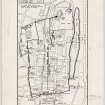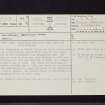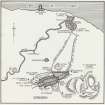Following the launch of trove.scot in February 2025 we are now planning the retiral of some of our webservices. Canmore will be switched off on 24th June 2025. Information about the closure can be found on the HES website: Retiral of HES web services | Historic Environment Scotland
Edinburgh, Franciscan Friary
Friary (Medieval)
Site Name Edinburgh, Franciscan Friary
Classification Friary (Medieval)
Alternative Name(s) Greyfriars Friary; Greyfriars Monastery; Grassmarket; Candlemaker Row
Canmore ID 52245
Site Number NT27SE 22
NGR NT 2550 7338
Datum OSGB36 - NGR
Permalink http://canmore.org.uk/site/52245
- Council Edinburgh, City Of
- Parish Edinburgh (Edinburgh, City Of)
- Former Region Lothian
- Former District City Of Edinburgh
- Former County Midlothian
NT27SE 22 2550 7338
(NT 2550 7338) Greyfriars Monastery (NR)
(Site of) (15th Century)
OS 1/500 plan, (1895)
The Franciscan or 'Grey' Friars had their church and friary on the sloping ground that occupies the angle formed by the Grassmarket and Candlemaker Row. Six friars are said to have come from Holland in 1447, and their house and land was occupied in 1455, or, perhaps more correctly, in 1458. The friary was destroyed by Reformers in 1559, and in 1562, the Queen was petitioned by the Town Council to grant the yards of the Greyfriars as a burial ground. The parish church of Greyfriars was subsequently built on their land.
RCAHMS 1951; D E Easson 1957.
No traces of this friary now exist; the area is built up.
Visited by OS (J L D) 25 December 1953.
Publication Account (1951)
74. Franciscan Friary.
The Order of Friars Minor, the “Grey Friars”, had their church and convent on the sloping ground that occupies the angle formed by the Grassmarket and Candlemaker Row. The community came to Edinburgh in 1447, James Douglas of Cassilis taking a leading part in the arrangements for their reception (1). Permission to settle was granted to the Order by the Provost of the Church of St. Giles; he likewise allowed the Friars to make use of the neighbouring Chapel of St. John, which had belonged until 1437 to the Knights of St. John of Jerusalem (2). Neither drawing nor description of the structure has survived, but it was evidently a place of some pretensions as the first Warden, John Gormok, considered it altogether too sumptuous for the Order's use (3).
The Friars occupied themselves largely with medical missionary work among the sick poor; but they also distinguished themselves by the vigour of their opposition to the new doctrines. Like the Dominicans, they were attacked by the mob in 1559 and their house was eventually destroyed. For the parish church that subsequently arose on their land see [RCAHMS 1951] No. 7.
RCAHMS 1951
(1) Annales Minorum seu Trium Ordinum a Sancto Francisco Institutorum, ed. 1731, xi, p. 321, no. 89, and Reg. Mag. Sig., 1479, no. 1434. (2) Reg. Cart. St. Egid., pp. 111-2. (3) Annales Minorum, etc., loc. cit.












